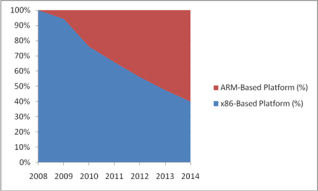Changing of the guard
The ultra-mobile device category has an irritatingly large number of sub-sets, with the tablet form-factor now a major addition.
As a broad definition we would say it encompasses all devices that run on a very lower power platform (Atom and below), but are too big to fit in your pocket. So that includes netbooks, but not thin-and-light notebooks and tablets but not smartphones.
Market researcher ABI research seems to agree and it has predicted that by 2013 platforms using the ARM instruction set, which includes SoCs like Qualcomm's Snapdragon and NVIDIA's Tegra, will replace x86 (essentially Intel in this category) as the most common platforms on ultra-mobile devices.
This year is essentially year 1 for ARM-based ultra-mobile devices, with CES featuring a bunch of launches from the likes of Lenovo that fit into this category and many more - not least whatever Apple has up its sleeve - expected to come. "2010 will be pivotal for building momentum behind non-x86 solutions, and gaining adoption in both distribution channels and by end-user populations worldwide," said Jeff Orr, senior analyst at ABI.
An equally important by-product of this trend is expected to be soaring demand for wireless data services. "Operators are working out their strategies for capacity expansion based on today's best expectations of future demand from data-centric devices," said Orr. "The main issues revolve around backhaul, followed by increased 3G and 4G BTS deployments."














